Fleeing for their lives
in Central America
Butting their heads against walls
– visible and invisible
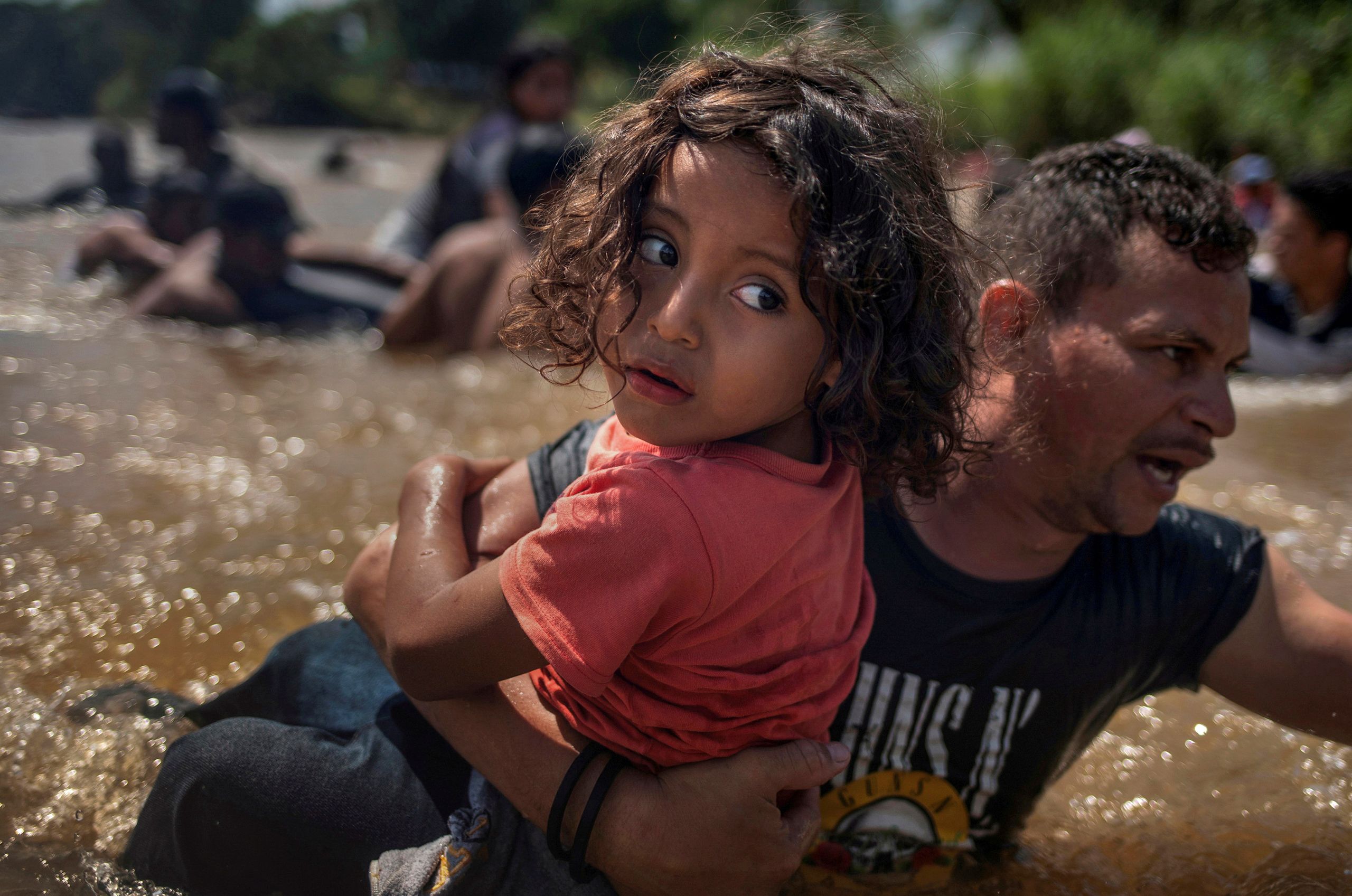

Richard Skretteberg,
Senior Adviser/ NRC
Migration from Central America to the United States is nothing new. But some of the reasons why people are leaving their homes are relatively new. More and more people are fleeing to find protection. It’s a matter of life and death.
The heart-breaking image of Oscar Alberto Martinez Ramirez and his two-year-old daughter, Valeria, in a close embrace, drowned on the banks of the Rio Grande, received a lot of attention in the international media in June. Oscar sacrificed his life in an attempt to present himself and his family to the US authorities to seek asylum. For many, thoughts returned to the three-year-old Syrian boy, Alan Kurdi, who was found drowned on a Mediterranean beach in 2015.
Crossing the 3,200 km border between the United States and Mexico, made up of desert and the sometimes rapid and rough waters of the Rio Grande, has become an undertaking where people must put their lives on the line. In 2018, 283 people lost their lives in the attempt.
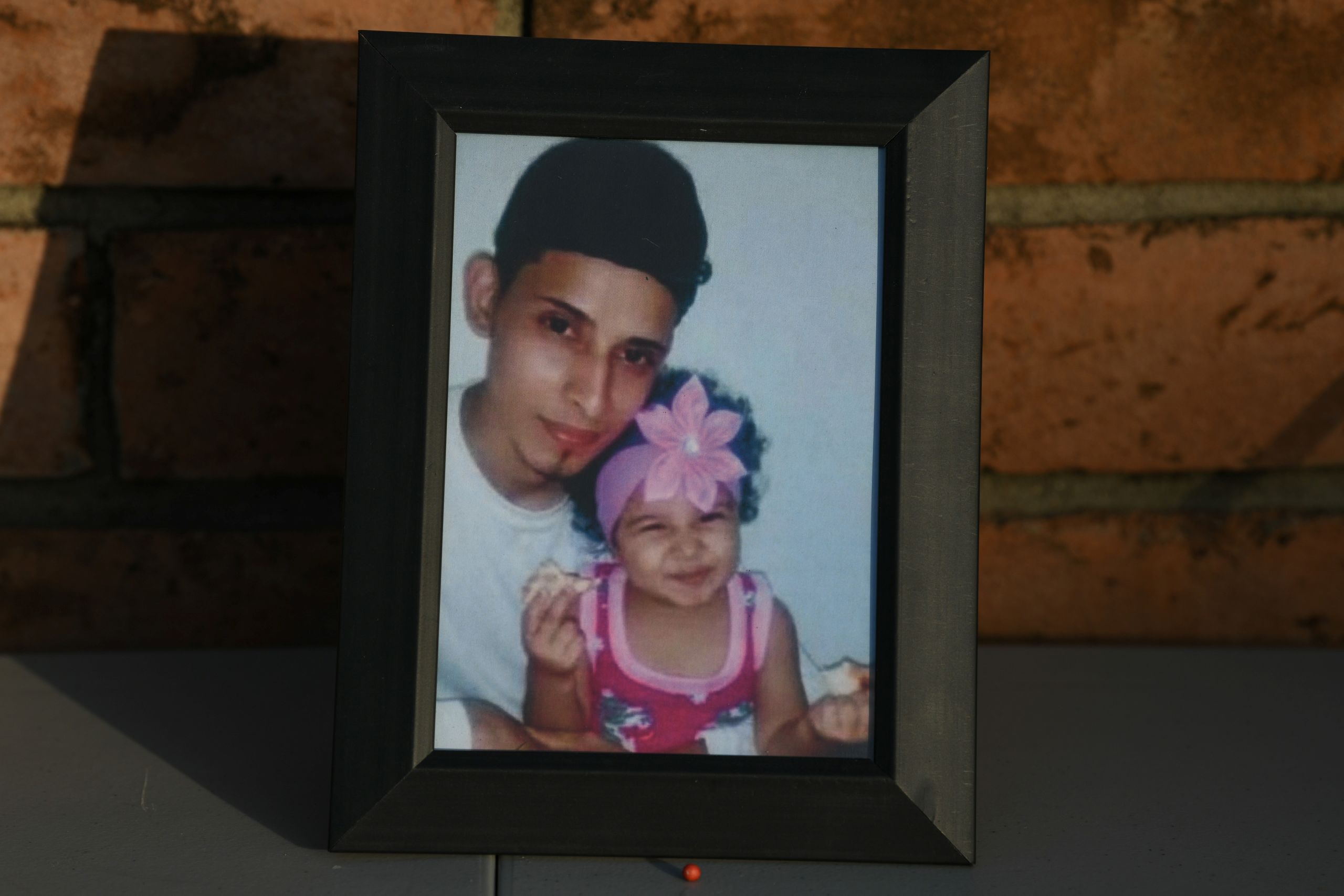
Salvadoran migrant Oscar Alberto Martinez Ramirez and his 23-month-old daughter Valeria, who drowned crossing the Rio Grande at the US-Mexico border, are remembered during a vigil in their honour in Brownsville, Texas, 30 June 2019. Photo: Loren Elliott/Reuters
New type of mass flight
A new type of mass flight has emerged in recent years in Guatemala, Honduras and El Salvador. According to the UN refugee agency, the number of refugees and asylum seekers from the countries of northern Central America increased by 54 per cent from mid-2017 to mid-2018. From October 2018 until the winter of early 2019, around 16,000 people, divided into five caravans, crossed the border between Guatemala and Mexico. The fact that people are gathering in caravans represents something new. It gives them a greater sense of security, and they can help each other.

A caravan originating in El Salvador left the southern state of Chiapas to enter Oaxaca and follow the same route as the previous contingents. After failing to get the UN to provide them with free transportation, the thousands of migrants camped in Mexico City agreed to leave the capital and resume their march on foot to the United States. Photo: Lusi Villalobos/EPA
Fleeing to uncertainty
When the fear of fleeing is less than the fear of staying, people leave. The long trip north is extremely dangerous and exhausting for the thousands of families who attempt it, mainly from Honduras, El Salvador and Guatemala. Over the years, the challenges of the journey have only increased. Where people were previously met with goodwill, frustration has grown in local communities along the route. In addition, there is growing xenophobia both in the United States and in Mexico, and increasingly tougher border controls.
The strict measures adopted in US refugee policy have led to a greater number of people than before seeking asylum in Mexico, Belize, Costa Rica and Panama, rather than continuing north to the United States.

Members of the Hope Border Institute hold photographs of migrant children who have died in attempts to enter the US, at the border bridge in Ciudad Juarez, Chihuahua state, Mexico, 27 June 2019. Photo: David Peinado/EPA
Children are dying
In April 2019, the US courts ruled in favour of the Trump administration, requiring asylum seekers to stay in Mexico while their asylum applications are being processed in the United States, despite the fact that asylum seekers are being abused in Mexican border areas. Many refugees now have to wait more than a year in Mexico because of the lengthy processing times.
Asylum seekers who have already entered the United States are being detained while their asylum application is processed. They must also pay a fee to apply for asylum. The US has received massive criticism for its policy of separating children from their parents and placing them in separate detention centres. A number of children have died while in detention.
In July, the Trump administration introduced further restrictions on asylum for Central American migrants. These new measures entail that asylum seekers travelling through another country will not qualify for asylum at the southern US border. In practice, this means that non-Mexican migrants who cross Mexico on their way to the United States will be denied asylum. The rule will also apply to children who have crossed the border alone. The results of this policy are difficult to predict, but many people who have been forced to flee are desperate, and a consequence may be new boat refugees entering the United States without going through Mexican territory.
So, what is the background to this development, and why are so many people fleeing their homes?

Salvadoran migrant Oscar Alberto Martinez Ramirez and his 23-month-old daughter Valeria, who drowned crossing the Rio Grande at the US-Mexico border, are remembered during a vigil in their honour in Brownsville, Texas, 30 June 2019. Photo: Loren Elliott/Reuters
Salvadoran migrant Oscar Alberto Martinez Ramirez and his 23-month-old daughter Valeria, who drowned crossing the Rio Grande at the US-Mexico border, are remembered during a vigil in their honour in Brownsville, Texas, 30 June 2019. Photo: Loren Elliott/Reuters

A caravan originating in El Salvador left the southern state of Chiapas to enter Oaxaca and follow the same route as the previous contingents. After failing to get the UN to provide them with free transportation, the thousands of migrants camped in Mexico City agreed to leave the capital and resume their march on foot to the United States. Photo: Lusi Villalobos/EPA
A caravan originating in El Salvador left the southern state of Chiapas to enter Oaxaca and follow the same route as the previous contingents. After failing to get the UN to provide them with free transportation, the thousands of migrants camped in Mexico City agreed to leave the capital and resume their march on foot to the United States. Photo: Lusi Villalobos/EPA

Members of the Hope Border Institute hold photographs of migrant children who have died in attempts to enter the US, at the border bridge in Ciudad Juarez, Chihuahua state, Mexico, 27 June 2019. Photo: David Peinado/EPA
Members of the Hope Border Institute hold photographs of migrant children who have died in attempts to enter the US, at the border bridge in Ciudad Juarez, Chihuahua state, Mexico, 27 June 2019. Photo: David Peinado/EPA
More people are being forced to flee
Although the age of military dictatorships is past in Central America, democratisation processes are far from complete. Central American countries are struggling with poverty, corruption, unemployment and a lack of hope for the future. This explains why, for decades, many people have wanted to migrate to the United States. But the caravans and the desperation are an expression of something else. People are fleeing for their lives and seeking protection. The keyword is violence, and it is a type of violence that is difficult to understand unless you experience its effects first-hand.
When former Attorney General Jeff Sessions ordered that violence by non-governmental groups should no longer be an acceptable basis for protection, it was an obvious attempt to further tighten US refugee policy. However, in December 2018, a US federal court decided that this instruction violated US law. So, what kind of violence are we talking about?
Young people are particularly affected
Over the past ten years, the death rate among children and young people in El Salvador has been 53 per cent higher than among adults. Street gangs are paralysing parts of society in Guatemala, El Salvador and Honduras. In places where gangs have acquired territorial control, social structures disintegrate. Brutality is their hallmark, and by spreading fear, the gangs gain power.
According to surveys that NRC has conducted in El Salvador and Honduras, almost half of the children living in areas with high levels of violence and crime have dropped out of school. Children experience threats, pressure and abuse. The way to school is dangerous, and children often have to cross the territories of warring criminal gangs. Gang members are even present in the schools themselves. They sell drugs, extort from teachers and students, and recruit new members.
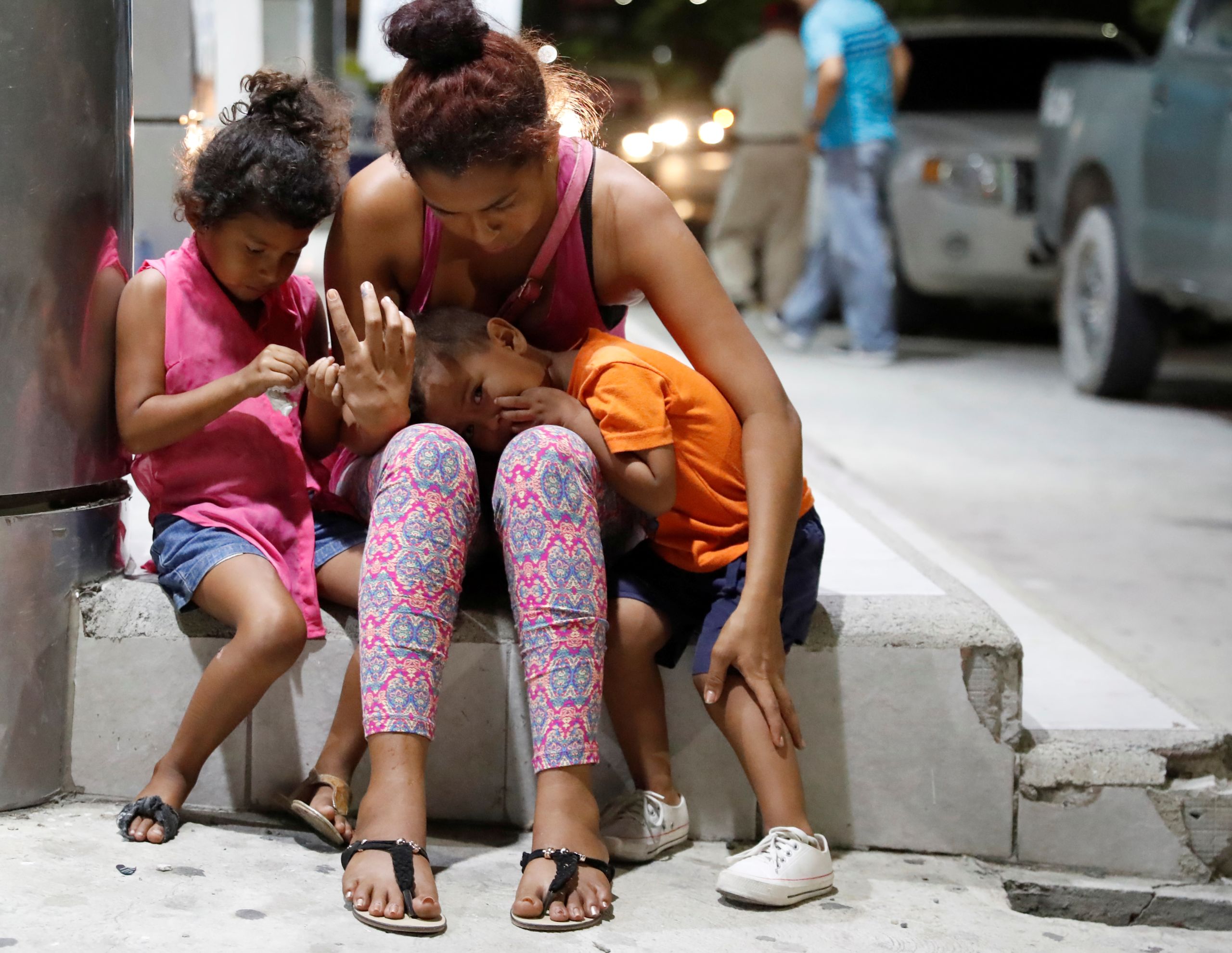
Fransisca Sislavas sits next to her daughter Brittany and her son Rony after an unidentified [gang] gunman killed her husband in a taxi in San Pedro Sula, Honduras, 26 July 2018. They were all in the vehicle at the time of the killing. Photo: Goran Tomasevic/Reuters
Started in the US
One of the largest and oldest criminal organisations is Mara Salvatrucha, or MS-13, which was originally founded in Los Angeles back in the late 1970s. The main leaders of this gang were young people from El Salvador who had emigrated to the United States or fled the civil war in their home country. They claimed that they were defending themselves against Mexican gangs, and to finance this, they turned to organised crime where drug trafficking and human trafficking were the main sources of income. In the following decades, both MS-13 and other similar groups spread across much of Central America. Now, it is the children and grandchildren of the first leaders who are leading the gangs.
The reason they spread so quickly was that the US government began returning imprisoned gang members to Central America in the 1990s. El Salvador and Guatemala had barely recovered from civil wars and were very poorly equipped to deal with this type of crime. The large numbers of weapons in circulation, together with poverty, corruption, widespread impunity and weak state institutions, allowed the gangs to quickly take root.
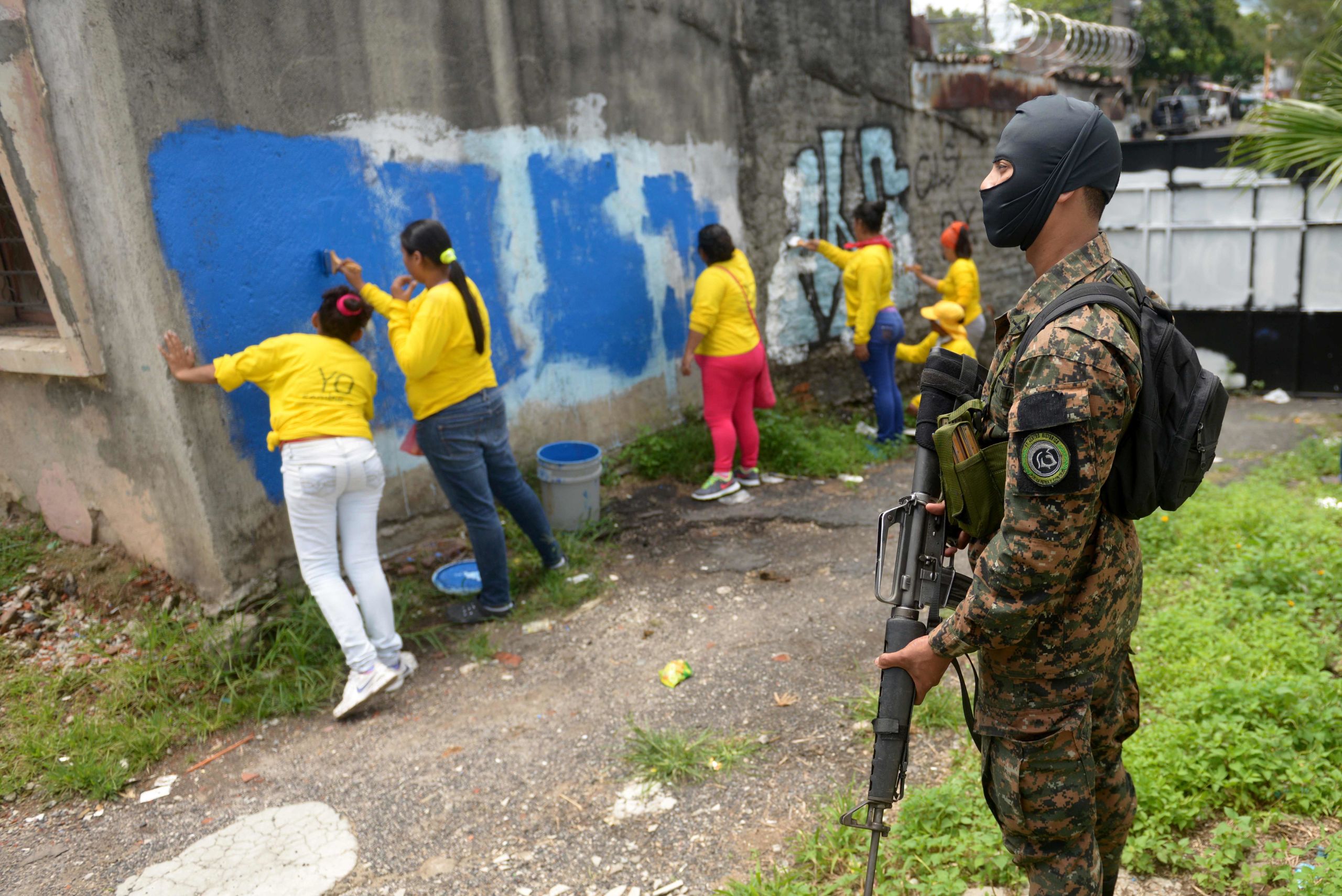
A soldier stands guard (R) while parolees paint over graffiti associated with the Mara Salvatrucha gang in San Salvador, during an operation to take back gang-controlled neighbourhoods on 16 August 2016. The Salvatrucha (MS-13) and 18th Street gangs are the main cause of the violence escalation plaguing El Salvador, where an estimated 60,000 people belong to gangs, 15,000 of them in prison. Photo: Marvin Recinos/AFP
When violence becomes the norm
MS-13 is one of the world’s largest organised gangs and has tens of thousands of members. The absence of hope for the future and, for many, an upbringing without a father – because many of their fathers are migrants – makes vulnerable young people open to being recruited. The gangs give them a sense of belonging that they didn’t have before, but at the same time, there is no way back. The internal justice is fierce and totally ruthless. Those who refuse to allow themselves to be recruited are in mortal danger.
The gangs terrorise the population with extreme violence in the form of murder, rape, threats, blackmail and kidnappings, and they make huge amounts of money on drug sales, human trafficking and arms dealing. With money and good contacts high up in the political system, they often escape punishment. Impunity is widespread and is one of the reasons why much of the population does not trust the authorities.

A migrant boy, part of a caravan from Central America trying to reach the US, cries due to the excess heat and humidity as migrants seek asylum at the Guatemala-Mexico border checkpoint in Ciudad Hidalgo, Mexico, 20 October 2018. Photo: Edgard Garrido/Reuters
People who live under the control of the gangs are afraid to go to school, go out to the shops or visit friends – every single day. They have little freedom of movement and many live large parts of their childhood behind walls and locked doors.
It is very challenging to carry out humanitarian aid work under such conditions. The boundaries between the territories controlled by different criminal gangs are invisible, and aid workers must gain acceptance from these groups in order to enter their territories. Most humanitarian aid work is conducted at schools and municipal centres, but there are still many areas that are inaccessible.

A soldier stands guard (R) while parolees paint over graffiti associated with the Mara Salvatrucha gang in San Salvador, during an operation to take back gang-controlled neighbourhoods on 16 August 2016. The Salvatrucha (MS-13) and 18th Street gangs are the main cause of the violence escalation plaguing El Salvador, where an estimated 60,000 people belong to gangs, 15,000 of them in prison. Photo: Marvin Recinos/AFP
A soldier stands guard (R) while parolees paint over graffiti associated with the Mara Salvatrucha gang in San Salvador, during an operation to take back gang-controlled neighbourhoods on 16 August 2016. The Salvatrucha (MS-13) and 18th Street gangs are the main cause of the violence escalation plaguing El Salvador, where an estimated 60,000 people belong to gangs, 15,000 of them in prison. Photo: Marvin Recinos/AFP

Fransisca Sislavas sits next to her daughter Brittany and her son Rony after an unidentified [gang] gunman killed her husband in a taxi in San Pedro Sula, Honduras, 26 July 2018. They were all in the vehicle at the time of the killing. Photo: Goran Tomasevic/Reuters
Fransisca Sislavas sits next to her daughter Brittany and her son Rony after an unidentified [gang] gunman killed her husband in a taxi in San Pedro Sula, Honduras, 26 July 2018. They were all in the vehicle at the time of the killing. Photo: Goran Tomasevic/Reuters

A migrant boy, part of a caravan from Central America trying to reach the US, cries due to the excess heat and humidity as migrants seek asylum at the Guatemala-Mexico border checkpoint in Ciudad Hidalgo, Mexico, 20 October 2018. Photo: Edgard Garrido/Reuters
A migrant boy, part of a caravan from Central America trying to reach the US, cries due to the excess heat and humidity as migrants seek asylum at the Guatemala-Mexico border checkpoint in Ciudad Hidalgo, Mexico, 20 October 2018. Photo: Edgard Garrido/Reuters
The clammy hand of corruption
There is little confidence in the authorities among much of the population in Honduras, El Salvador and Guatemala. Politicians are regarded less as people in a position of trust and more as people who exploit their position of power for personal gain. Laws are often not implemented in practice. The violence continues, and corruption creates impunity and limits benefits. If you don’t have money and connections, it is very difficult to change your life situation. If you are born poor, chances are that you will remain poor.
In January 2019, President Jimmy Morales declared that Guatemala was withdrawing from the agreement that facilitated the work of the International Commission against Impunity in Guatemala (CICIG). The commission, set up by the UN in 2007, was supposed to investigate and prosecute illegal and corrupt networks within the state apparatus.
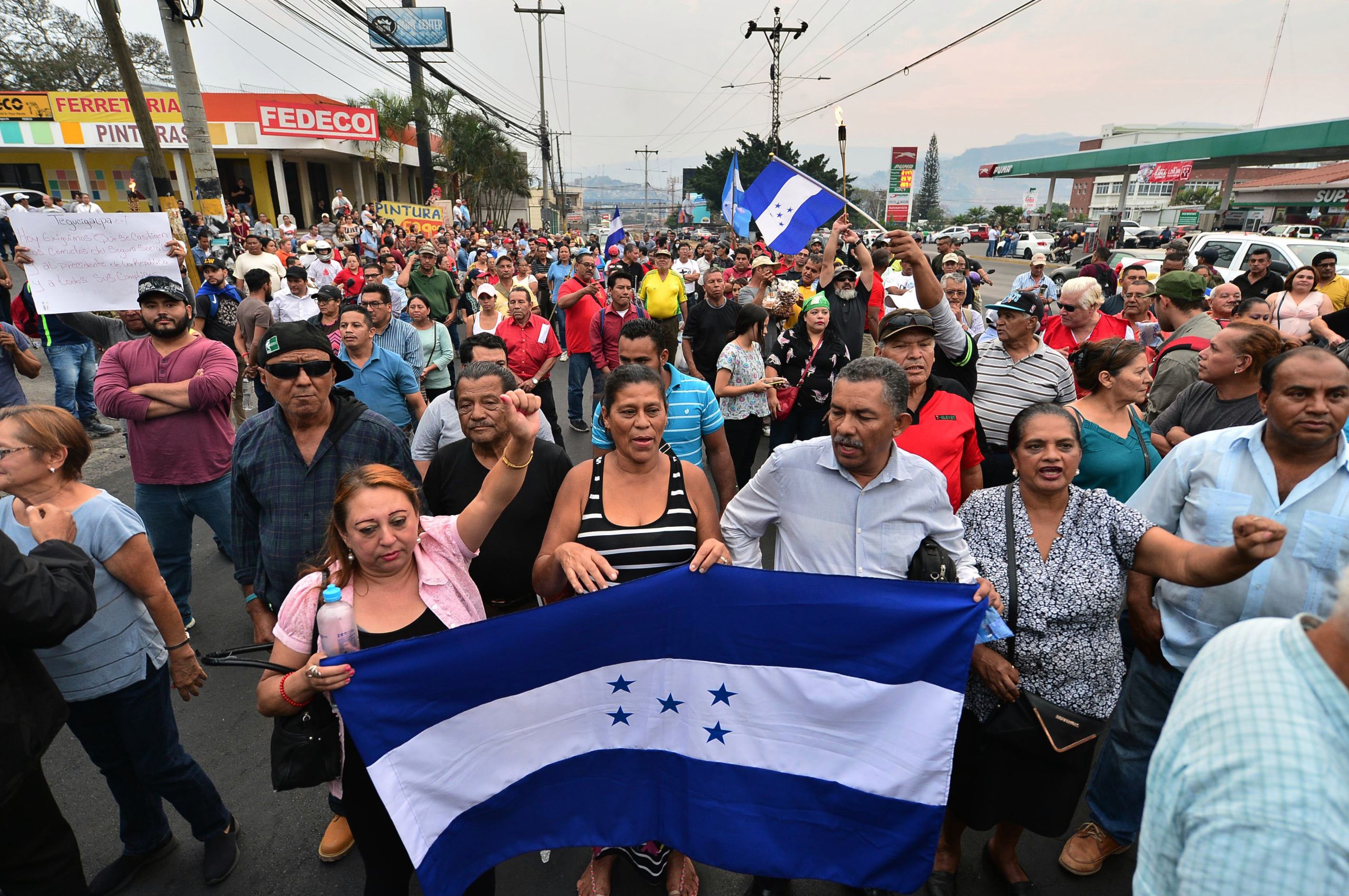
Demonstrators march from Globo radio station towards the headquarters of the Mission to Support the Fight against Corruption and Impunity in Honduras (MACCIH), to demand the release of Honduran journalist David Romero, who was sentenced to ten years in prison for defamation on 29 March 2019. Honduran police raided the Globo radio facilities to arrest Romero, despite the Inter-American Commission on Human Rights (IACHR) ordering protective measures in his favour. Photo: Orlando Sierra/AFP
Walls are no solution
President Trump is still building a border wall against Mexico, but has not yet managed to get Congress to finance the project. Meanwhile, a large number of soldiers have been deployed to the border to assist border guards, and there was a sharp increase in the number of arrests for illegal border crossings in 2018. Trump is threatening Mexico with increased trade tariffs if they don’t help stem the flow of migrants to the US border. Trump has also stated that he wants to refuse asylum to anyone who has resided in other Central American countries before seeking asylum in the United States.
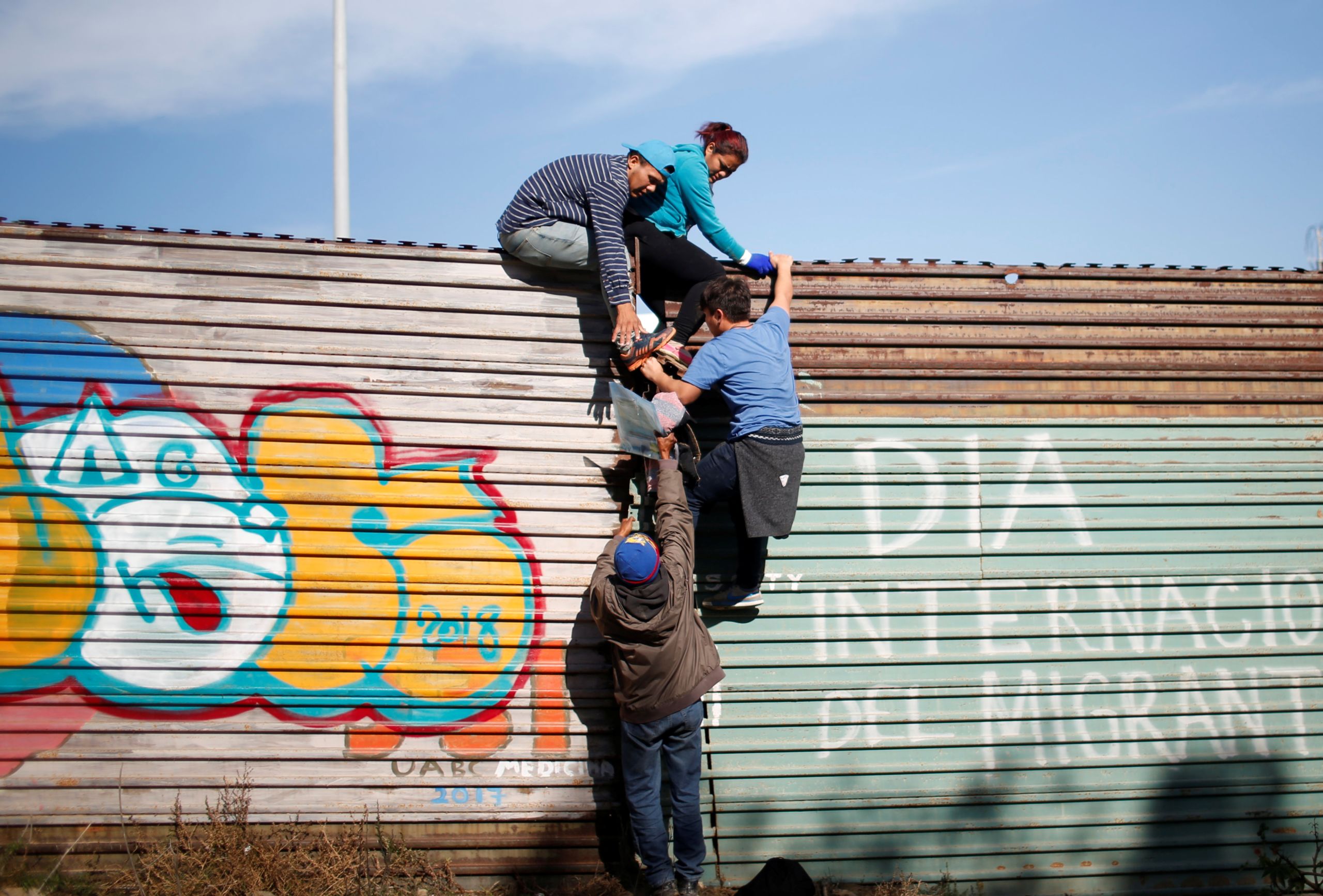
Migrants from Honduras, part of a caravan of thousands from Central America trying to reach the United States, jump a border fence in Tijuana to cross illegally from Mexico to the US, 12 December 2018. Photo: Mohammed Salem/Reuters
A humanitarian crisis requires a humanitarian response
As long as the situation continues, no amount of border controls, border guards and border walls will be able to stop people fleeing gang crime and violence. Young people who have lost all hope of a safe future in Central America will continue to seek a better life in the United States, Canada or Mexico. Investing in education, jobs, and violence prevention is a far better alternative to the deprivation of liberty and forced return that we see today. A total of 75,279 people were deported from Mexico and the United States in 2018 alone, according to Observatorio Consular y Migratorio de Honduras, a centre for migration in Honduras.
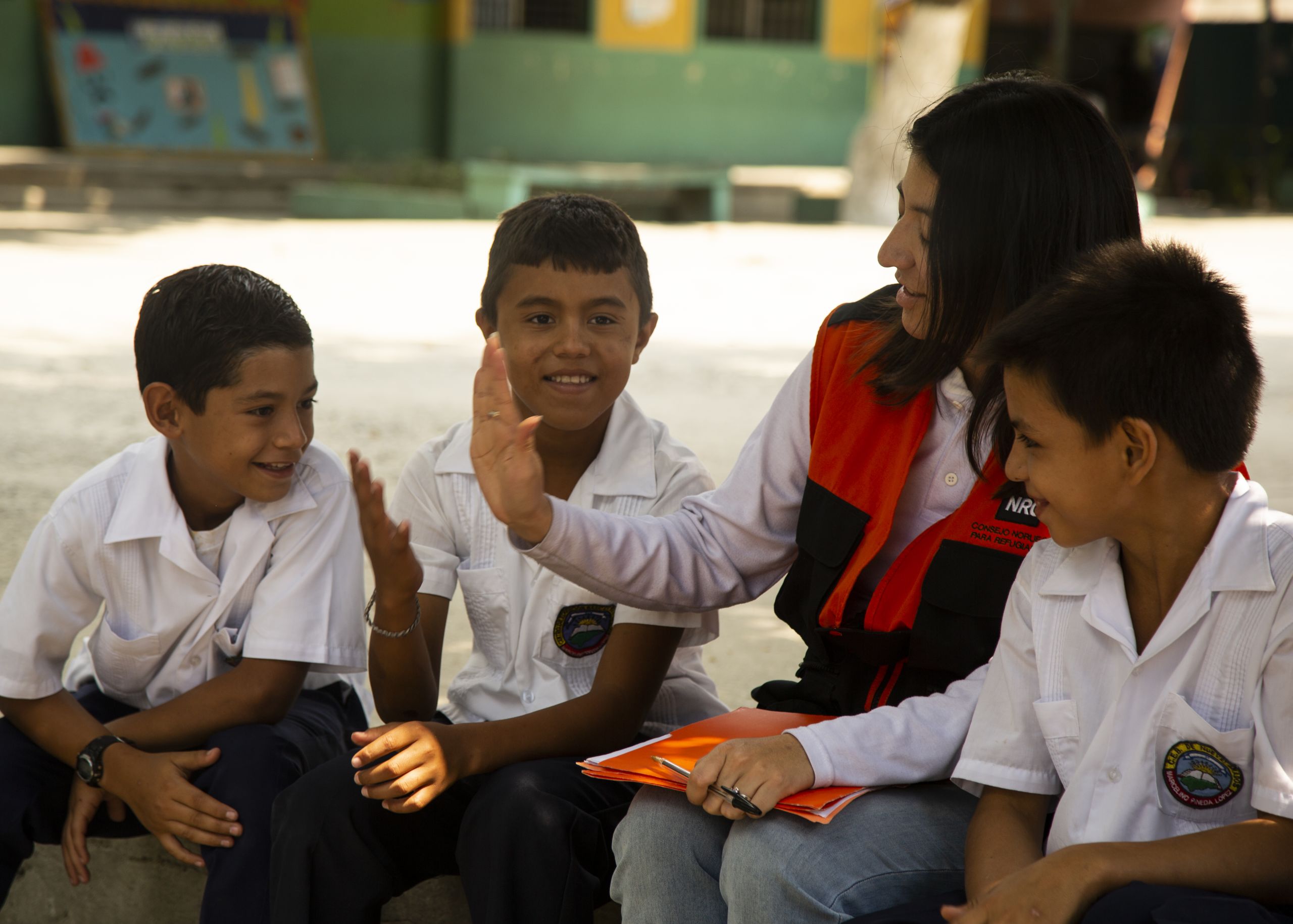
Almost half of all the children surveyed who live in areas of high violence and crime in Honduras and El Salvador do not attend school, according to surveys conducted by the Norwegian Refugee Council. These three boys have returned to school through NRC’s education project. Photo: NRC
The Norwegian Refugee Council (NRC) and eight other humanitarian aid organisations have urged the UN to develop a regional plan to raise international awareness of the humanitarian crisis that is currently taking place in northern Central America. States, donors and the humanitarian aid system must all move in the same direction.

Demonstrators march from Globo radio station towards the headquarters of the Mission to Support the Fight against Corruption and Impunity in Honduras (MACCIH), to demand the release of Honduran journalist David Romero, who was sentenced to ten years in prison for defamation on 29 March 2019. Honduran police raided the Globo radio facilities to arrest Romero, despite the Inter-American Commission on Human Rights (IACHR) ordering protective measures in his favour. Photo: Orlando Sierra/AFP
Demonstrators march from Globo radio station towards the headquarters of the Mission to Support the Fight against Corruption and Impunity in Honduras (MACCIH), to demand the release of Honduran journalist David Romero, who was sentenced to ten years in prison for defamation on 29 March 2019. Honduran police raided the Globo radio facilities to arrest Romero, despite the Inter-American Commission on Human Rights (IACHR) ordering protective measures in his favour. Photo: Orlando Sierra/AFP

Migrants from Honduras, part of a caravan of thousands from Central America trying to reach the United States, jump a border fence in Tijuana to cross illegally from Mexico to the US, 12 December 2018. Photo: Mohammed Salem/Reuters
Migrants from Honduras, part of a caravan of thousands from Central America trying to reach the United States, jump a border fence in Tijuana to cross illegally from Mexico to the US, 12 December 2018. Photo: Mohammed Salem/Reuters

Almost half of all the children surveyed who live in areas of high violence and crime in Honduras and El Salvador do not attend school, according to surveys conducted by the Norwegian Refugee Council. These three boys have returned to school through NRC’s education project. Photo: NRC
Almost half of all the children surveyed who live in areas of high violence and crime in Honduras and El Salvador do not attend school, according to surveys conducted by the Norwegian Refugee Council. These three boys have returned to school through NRC’s education project. Photo: NRC
Migration and flight in Central America
Factbox
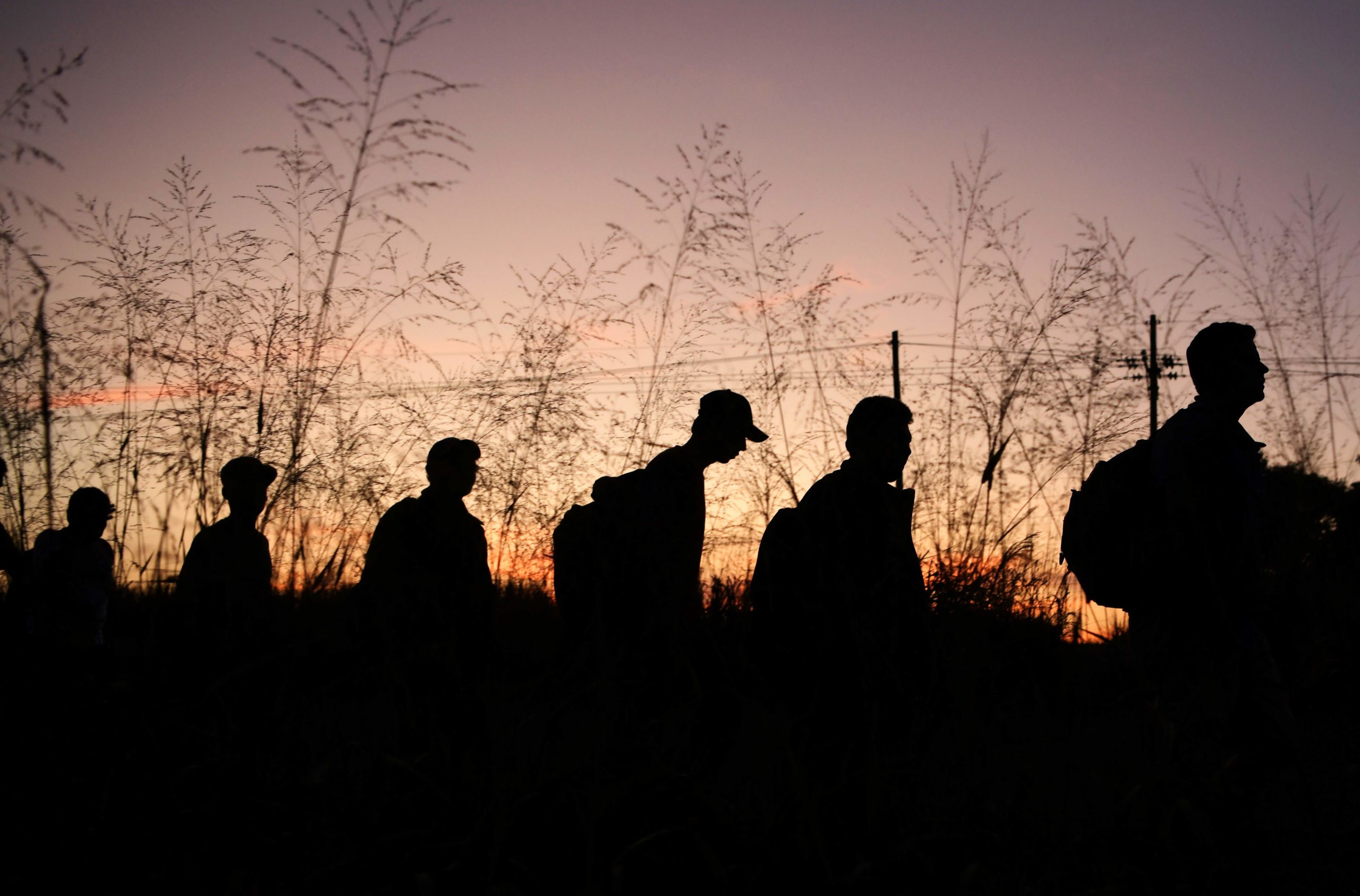

What is described as the “migration crisis” in Central America, especially the one originating in Honduras, El Salvador and Guatemala, is linked to major economic and social issues. Corruption and widespread impunity are also causing many to lose confidence in the authorities.

Several surveys conducted among migrants in 2016 and 2017 showed that 20–30 per cent cited insecurity as the main reason they left their home country.

Overall, there has been no dramatic increase in migrants from northern Central America to the United States. During the period 2009–2017, the increase was only 1.9 per cent. This is due to the fact that it has become more difficult to get into the US and more and more people have been sent back to their homeland.

The need for labour in the US has also been a major contributor to migration.
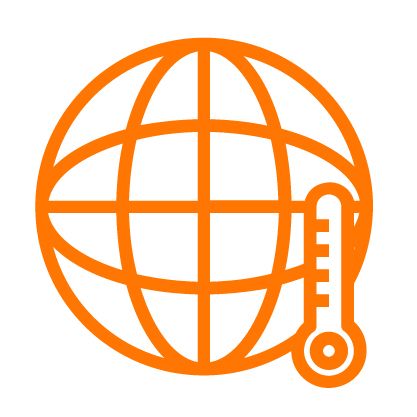
The countries in northern Central America are heavily dependent on the global economy, and their main exports in the agriculture sector now employ only a small proportion of the total workforce. At the same time, climate change is making Central America both drier and warmer. This makes it more difficult to run agriculture in the traditional way. Climate change is a relatively new factor that is contributing to more people embarking on the dangerous journey northwards.

Another source of income, tourism, is falling due to the increased violence.

Deportations from the US also mean that many families are losing out on money transfers from abroad. Money transfers accounted for over 50 per cent of the income of 3.5 million families in the region in 2015. Many now have to cope as best they can in the informal part of the economy, working as street vendors, housekeepers or small business owners.
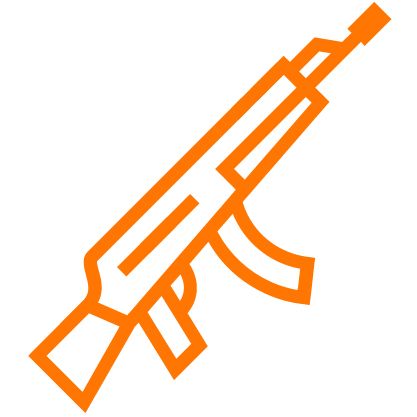
The effects of the coup in Honduras in 2009 and the expansion of organised crime in northern Central America over the last decade have negatively affected the situation. More and more people are fleeing their homes to seek protection against violence and abuse. We are no longer just facing a flow of migrants, but also a large number of displaced people.


